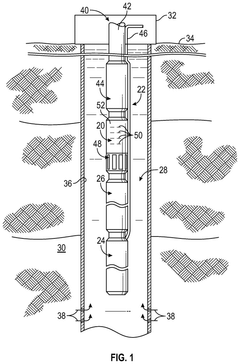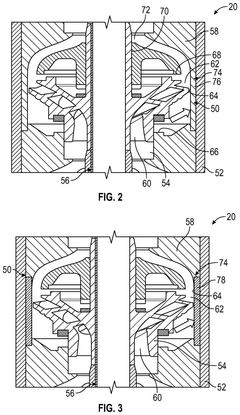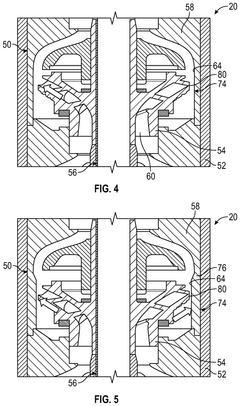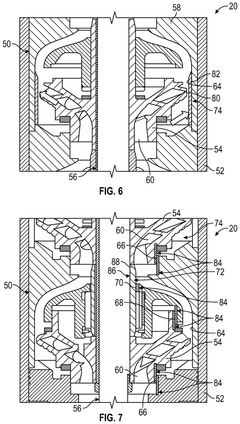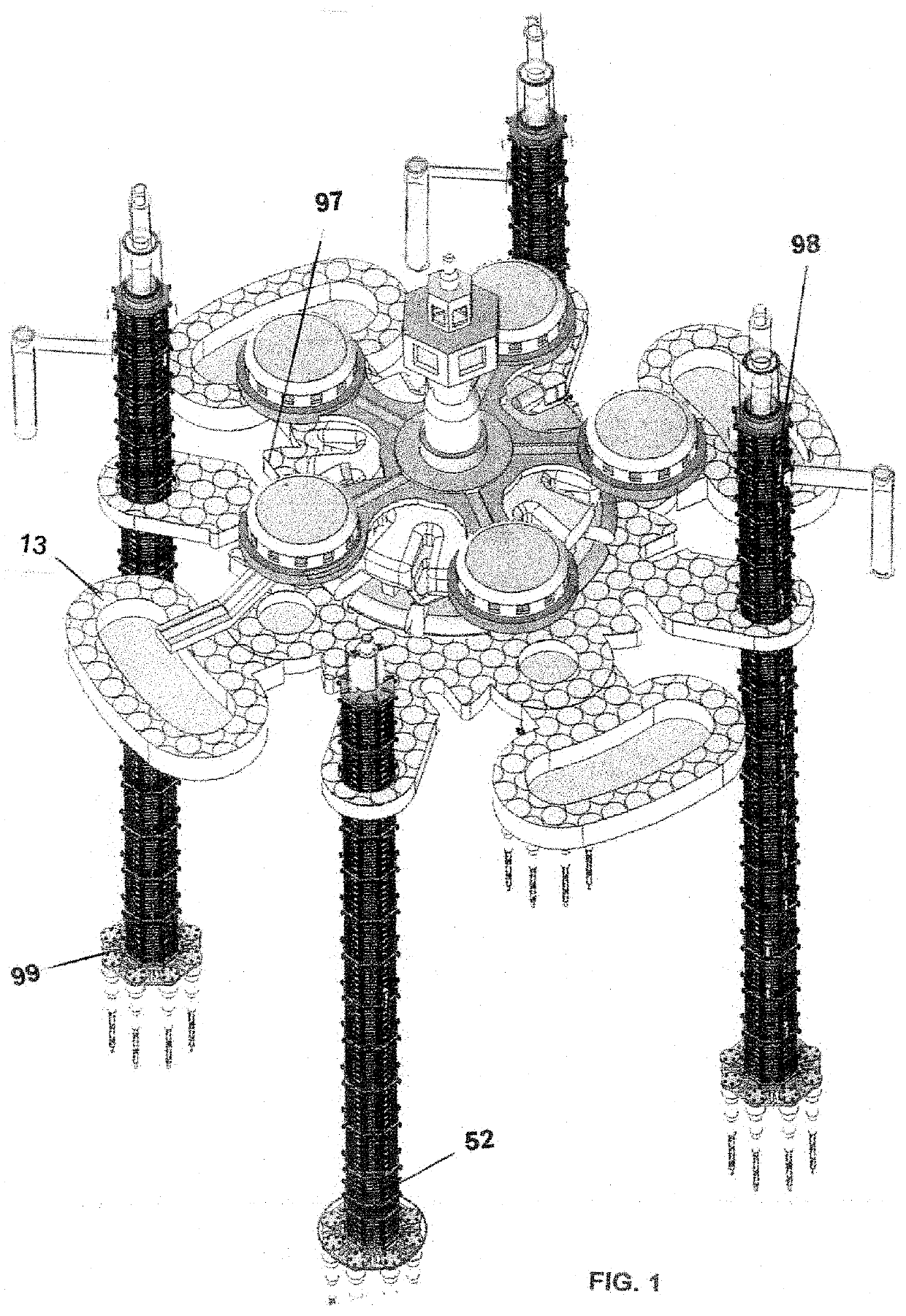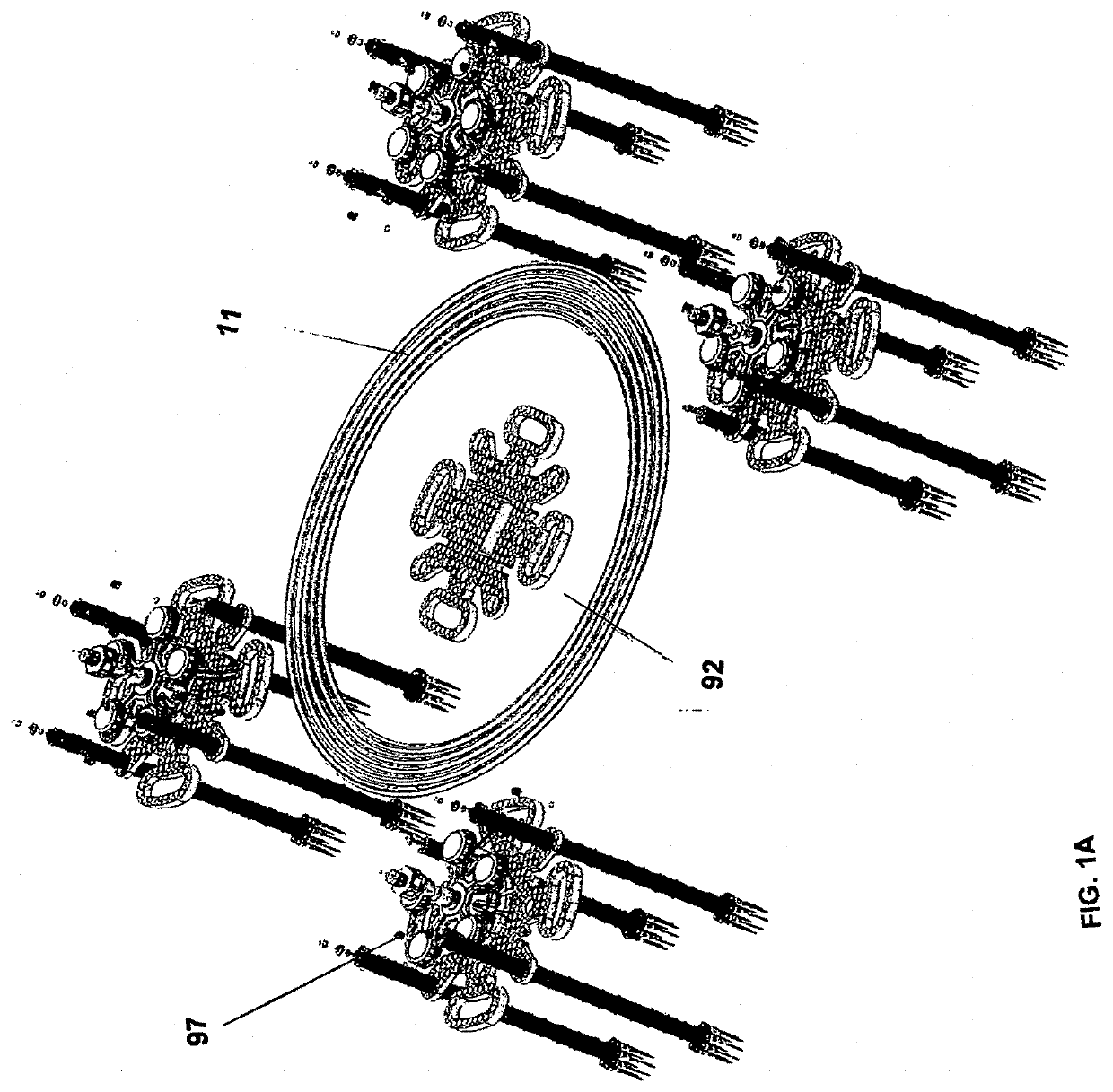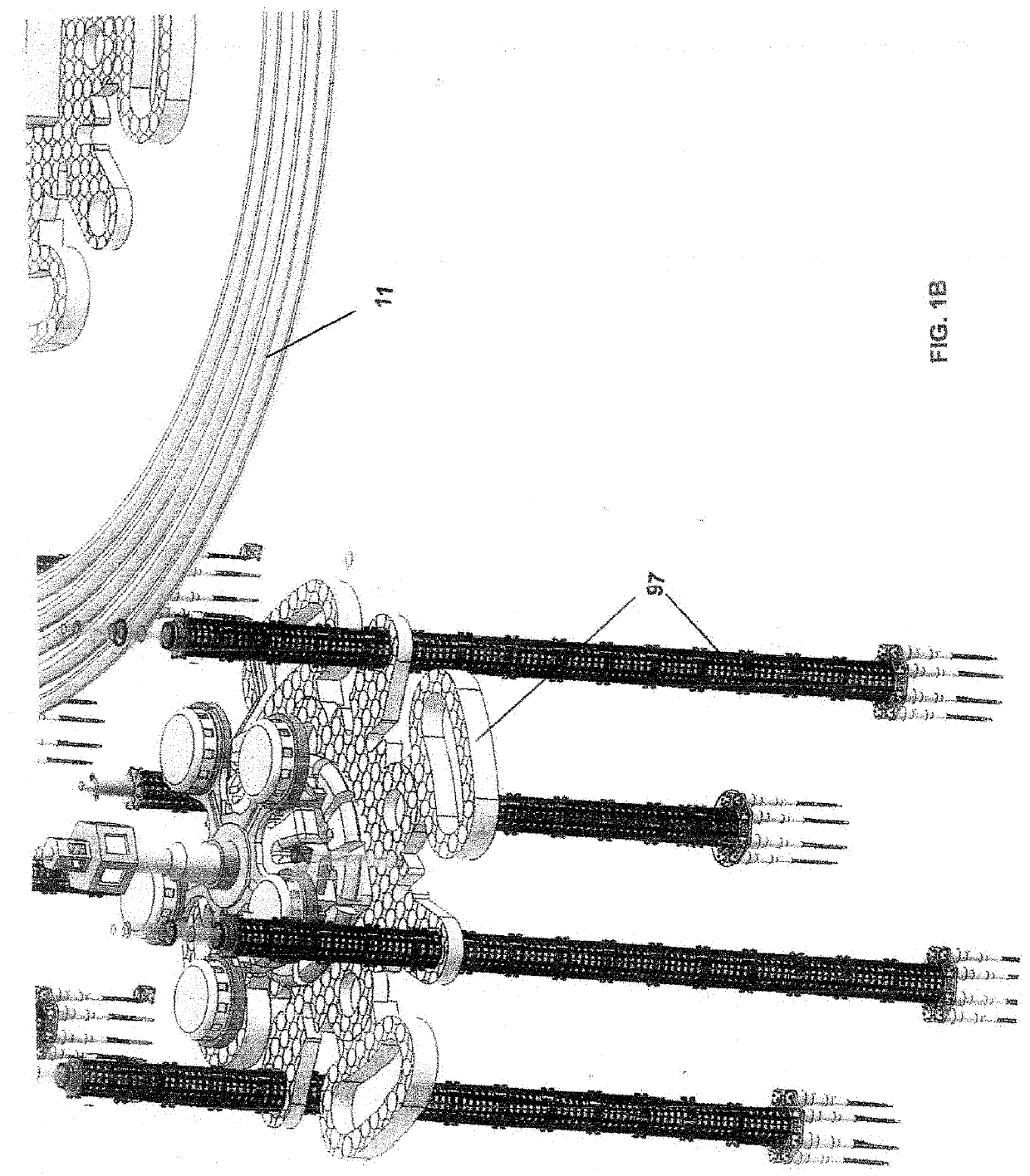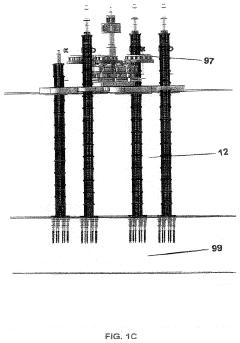Submersible pumps as a tool for coastal erosion prevention.
JUL 15, 20259 MIN READ
Generate Your Research Report Instantly with AI Agent
Patsnap Eureka helps you evaluate technical feasibility & market potential.
Submersible Pump Tech Evolution and Objectives
Submersible pumps have undergone significant technological evolution since their inception, with their potential application in coastal erosion prevention emerging as a promising frontier. The development of these pumps has been driven by the increasing need for efficient water management solutions in various sectors, including agriculture, mining, and now, environmental protection.
The history of submersible pumps dates back to the early 20th century, with initial designs focusing on basic water extraction capabilities. As technology advanced, so did the efficiency, durability, and versatility of these pumps. The 1960s and 1970s saw major breakthroughs in materials science and electrical engineering, leading to more robust and powerful submersible pump designs capable of operating in harsh underwater environments.
In recent years, the focus has shifted towards developing smart, energy-efficient submersible pumps with advanced control systems. These modern pumps incorporate sensors and IoT technology, allowing for real-time monitoring and adjustment of pump performance. This evolution has opened up new possibilities for their application in complex environmental challenges such as coastal erosion prevention.
The primary objective of researching submersible pumps for coastal erosion prevention is to develop innovative solutions that can effectively mitigate the impact of rising sea levels and increasingly frequent storm surges. By strategically deploying submersible pumps, it may be possible to manipulate water flow patterns, redistribute sediment, and create protective barriers against erosive forces.
Key technical goals in this research include enhancing pump efficiency to handle large volumes of water and sediment, improving durability to withstand corrosive saltwater environments, and developing intelligent control systems that can adapt to changing coastal conditions. Additionally, there is a focus on minimizing environmental impact, ensuring that the pumps do not disrupt local ecosystems while performing their erosion prevention function.
Another crucial objective is to integrate submersible pump systems with other coastal protection measures, creating comprehensive and sustainable solutions for erosion control. This involves exploring how pumps can work in tandem with natural defenses, such as mangroves or artificial reefs, to provide multi-layered protection for vulnerable coastlines.
As climate change continues to exacerbate coastal erosion worldwide, the development of innovative technologies like submersible pumps for erosion prevention has become increasingly urgent. The evolution of this technology and the clear objectives set for its application in coastal protection represent a significant step forward in our ability to adapt to and mitigate the effects of climate change on coastal communities and ecosystems.
The history of submersible pumps dates back to the early 20th century, with initial designs focusing on basic water extraction capabilities. As technology advanced, so did the efficiency, durability, and versatility of these pumps. The 1960s and 1970s saw major breakthroughs in materials science and electrical engineering, leading to more robust and powerful submersible pump designs capable of operating in harsh underwater environments.
In recent years, the focus has shifted towards developing smart, energy-efficient submersible pumps with advanced control systems. These modern pumps incorporate sensors and IoT technology, allowing for real-time monitoring and adjustment of pump performance. This evolution has opened up new possibilities for their application in complex environmental challenges such as coastal erosion prevention.
The primary objective of researching submersible pumps for coastal erosion prevention is to develop innovative solutions that can effectively mitigate the impact of rising sea levels and increasingly frequent storm surges. By strategically deploying submersible pumps, it may be possible to manipulate water flow patterns, redistribute sediment, and create protective barriers against erosive forces.
Key technical goals in this research include enhancing pump efficiency to handle large volumes of water and sediment, improving durability to withstand corrosive saltwater environments, and developing intelligent control systems that can adapt to changing coastal conditions. Additionally, there is a focus on minimizing environmental impact, ensuring that the pumps do not disrupt local ecosystems while performing their erosion prevention function.
Another crucial objective is to integrate submersible pump systems with other coastal protection measures, creating comprehensive and sustainable solutions for erosion control. This involves exploring how pumps can work in tandem with natural defenses, such as mangroves or artificial reefs, to provide multi-layered protection for vulnerable coastlines.
As climate change continues to exacerbate coastal erosion worldwide, the development of innovative technologies like submersible pumps for erosion prevention has become increasingly urgent. The evolution of this technology and the clear objectives set for its application in coastal protection represent a significant step forward in our ability to adapt to and mitigate the effects of climate change on coastal communities and ecosystems.
Coastal Erosion Prevention Market Analysis
The coastal erosion prevention market is experiencing significant growth due to increasing awareness of climate change impacts and the urgent need to protect coastal communities and infrastructure. The global market for coastal erosion prevention solutions is projected to reach substantial figures in the coming years, driven by rising sea levels, extreme weather events, and urbanization in coastal areas.
Submersible pumps, as a tool for coastal erosion prevention, represent an innovative approach within this market. These pumps offer a unique solution by manipulating water flow and sediment transport, potentially mitigating erosion effects. The demand for such technology is particularly high in regions with vulnerable coastlines, including parts of North America, Europe, and Asia-Pacific.
The market for submersible pumps in coastal erosion prevention is still emerging, with potential for rapid expansion. Factors driving this growth include the increasing frequency and intensity of coastal storms, the need for sustainable and environmentally friendly solutions, and government initiatives to protect coastal assets. Additionally, the versatility of submersible pumps, which can be used in conjunction with other erosion prevention methods, enhances their market appeal.
Key market segments for submersible pumps in coastal erosion prevention include beach nourishment projects, coastal infrastructure protection, and habitat restoration. The technology's ability to work in various water depths and conditions makes it adaptable to different coastal environments, from sandy beaches to rocky shorelines.
Market trends indicate a shift towards integrated coastal management solutions, where submersible pumps play a crucial role in comprehensive erosion control strategies. This approach combines hard engineering solutions with softer, nature-based interventions, creating a growing niche for submersible pump technology.
The competitive landscape of this market segment is diverse, including established pump manufacturers expanding into coastal applications, specialized coastal engineering firms, and innovative startups developing custom solutions. Collaboration between technology providers, coastal engineers, and environmental scientists is becoming increasingly common, driving innovation and market growth.
Challenges in the market include the need for long-term performance data, regulatory hurdles in sensitive coastal environments, and the initial capital investment required for large-scale implementations. However, the potential for cost savings in long-term coastal protection and the increasing prioritization of climate adaptation measures by governments worldwide are expected to overcome these barriers.
As coastal communities and policymakers become more proactive in addressing erosion threats, the market for submersible pumps and related technologies is poised for continued expansion. The integration of smart technologies, remote monitoring capabilities, and energy-efficient designs are likely to further enhance the appeal and effectiveness of submersible pumps in coastal erosion prevention applications.
Submersible pumps, as a tool for coastal erosion prevention, represent an innovative approach within this market. These pumps offer a unique solution by manipulating water flow and sediment transport, potentially mitigating erosion effects. The demand for such technology is particularly high in regions with vulnerable coastlines, including parts of North America, Europe, and Asia-Pacific.
The market for submersible pumps in coastal erosion prevention is still emerging, with potential for rapid expansion. Factors driving this growth include the increasing frequency and intensity of coastal storms, the need for sustainable and environmentally friendly solutions, and government initiatives to protect coastal assets. Additionally, the versatility of submersible pumps, which can be used in conjunction with other erosion prevention methods, enhances their market appeal.
Key market segments for submersible pumps in coastal erosion prevention include beach nourishment projects, coastal infrastructure protection, and habitat restoration. The technology's ability to work in various water depths and conditions makes it adaptable to different coastal environments, from sandy beaches to rocky shorelines.
Market trends indicate a shift towards integrated coastal management solutions, where submersible pumps play a crucial role in comprehensive erosion control strategies. This approach combines hard engineering solutions with softer, nature-based interventions, creating a growing niche for submersible pump technology.
The competitive landscape of this market segment is diverse, including established pump manufacturers expanding into coastal applications, specialized coastal engineering firms, and innovative startups developing custom solutions. Collaboration between technology providers, coastal engineers, and environmental scientists is becoming increasingly common, driving innovation and market growth.
Challenges in the market include the need for long-term performance data, regulatory hurdles in sensitive coastal environments, and the initial capital investment required for large-scale implementations. However, the potential for cost savings in long-term coastal protection and the increasing prioritization of climate adaptation measures by governments worldwide are expected to overcome these barriers.
As coastal communities and policymakers become more proactive in addressing erosion threats, the market for submersible pumps and related technologies is poised for continued expansion. The integration of smart technologies, remote monitoring capabilities, and energy-efficient designs are likely to further enhance the appeal and effectiveness of submersible pumps in coastal erosion prevention applications.
Current Challenges in Submersible Pump Technology
Submersible pumps, while effective in various applications, face several challenges when utilized for coastal erosion prevention. One of the primary issues is the harsh marine environment, which subjects the pumps to corrosive saltwater and abrasive sediments. This accelerates wear and tear on pump components, leading to reduced efficiency and increased maintenance requirements. The constant exposure to sand and other particulates can cause clogging and damage to impellers, seals, and bearings, necessitating frequent repairs or replacements.
Another significant challenge is the need for reliable power sources in remote coastal areas. Many erosion-prone locations lack easy access to electrical grids, making it difficult to operate submersible pumps continuously. While solar and wind power options exist, they may not always provide consistent energy output, especially during adverse weather conditions when erosion risks are highest.
The dynamic nature of coastal environments presents additional complications. Tidal fluctuations and storm surges can dramatically alter water levels and flow patterns, requiring pumps to adapt to varying conditions. This variability makes it challenging to maintain optimal pump performance and efficiency across different scenarios. Furthermore, the pumps must be designed to withstand extreme weather events, which are becoming more frequent due to climate change.
Sediment management is another critical issue. While submersible pumps can effectively move water, they may struggle with the high sediment loads typical in coastal areas. This can lead to pump clogging, reduced flow rates, and increased energy consumption. Developing pumps that can handle mixed water-sediment flows without compromising performance remains a technical hurdle.
Environmental concerns also pose challenges. The operation of submersible pumps in sensitive coastal ecosystems must be carefully managed to minimize impacts on marine life and habitats. This includes considerations for noise pollution, potential disruption of local hydrodynamics, and the risk of inadvertently pumping marine organisms along with water and sediment.
Lastly, the scalability of submersible pump solutions for large-scale coastal erosion prevention projects is a significant challenge. Designing systems that can effectively protect extensive coastlines while remaining cost-effective and environmentally sustainable requires innovative approaches to pump technology, deployment strategies, and integration with other erosion control methods.
Another significant challenge is the need for reliable power sources in remote coastal areas. Many erosion-prone locations lack easy access to electrical grids, making it difficult to operate submersible pumps continuously. While solar and wind power options exist, they may not always provide consistent energy output, especially during adverse weather conditions when erosion risks are highest.
The dynamic nature of coastal environments presents additional complications. Tidal fluctuations and storm surges can dramatically alter water levels and flow patterns, requiring pumps to adapt to varying conditions. This variability makes it challenging to maintain optimal pump performance and efficiency across different scenarios. Furthermore, the pumps must be designed to withstand extreme weather events, which are becoming more frequent due to climate change.
Sediment management is another critical issue. While submersible pumps can effectively move water, they may struggle with the high sediment loads typical in coastal areas. This can lead to pump clogging, reduced flow rates, and increased energy consumption. Developing pumps that can handle mixed water-sediment flows without compromising performance remains a technical hurdle.
Environmental concerns also pose challenges. The operation of submersible pumps in sensitive coastal ecosystems must be carefully managed to minimize impacts on marine life and habitats. This includes considerations for noise pollution, potential disruption of local hydrodynamics, and the risk of inadvertently pumping marine organisms along with water and sediment.
Lastly, the scalability of submersible pump solutions for large-scale coastal erosion prevention projects is a significant challenge. Designing systems that can effectively protect extensive coastlines while remaining cost-effective and environmentally sustainable requires innovative approaches to pump technology, deployment strategies, and integration with other erosion control methods.
Existing Submersible Pump Solutions for Erosion Control
01 Submersible pumps for sand and sediment removal
Specialized submersible pumps are designed to remove sand and sediment from coastal areas, helping to mitigate erosion. These pumps can operate underwater and efficiently transport sediment-laden water, allowing for the management of coastal erosion by relocating sand and preventing beach loss.- Submersible pumps for sand and sediment removal: Specialized submersible pumps are designed to remove sand and sediment from coastal areas, helping to mitigate erosion. These pumps can operate underwater and efficiently transport sediment-laden water, assisting in beach nourishment and coastal protection efforts.
- Coastal protection structures incorporating pumps: Innovative coastal protection structures integrate submersible pumps to actively manage sediment transport. These systems can include breakwaters, groins, or artificial reefs with built-in pumping mechanisms to redistribute sand and reduce erosion impacts.
- Automated erosion monitoring and pump control systems: Advanced monitoring systems use sensors and data analysis to detect coastal erosion patterns and automatically control submersible pumps. These systems optimize sediment redistribution efforts by adjusting pump operation based on real-time environmental conditions.
- Energy-efficient submersible pumps for coastal applications: Development of energy-efficient submersible pumps specifically designed for coastal erosion management. These pumps utilize innovative technologies to reduce power consumption while maintaining high performance in challenging marine environments.
- Mobile pump systems for flexible coastal erosion management: Portable and adaptable submersible pump systems that can be easily deployed and relocated along coastlines. These mobile solutions allow for targeted erosion control efforts and can be quickly moved to address changing coastal dynamics or emergency situations.
02 Coastal protection structures incorporating pumps
Innovative coastal protection structures integrate submersible pumps to actively combat erosion. These systems may include breakwaters, groins, or artificial reefs with built-in pumping mechanisms to redistribute sediment and maintain beach profiles, offering a dynamic approach to coastal erosion control.Expand Specific Solutions03 Pump-driven sand bypass systems
Sand bypass systems utilizing submersible pumps are employed to transfer sand from areas of accretion to erosion-prone zones. These systems help maintain natural sediment transport patterns disrupted by coastal structures, ensuring a continuous supply of sand to eroding beaches.Expand Specific Solutions04 Underwater drainage systems with pumps
Submersible pumps are used in underwater drainage systems to reduce wave energy and stabilize beach slopes. By lowering the water table in the beach face, these systems can decrease erosion rates and promote beach accretion, offering a less visible alternative to traditional coastal protection methods.Expand Specific Solutions05 Automated erosion monitoring and pump control systems
Advanced systems combining sensors, data analysis, and submersible pumps are developed to monitor coastal erosion in real-time and automatically adjust pumping operations. These smart systems optimize sediment management, allowing for rapid response to changing coastal conditions and more efficient erosion control.Expand Specific Solutions
Key Players in Coastal Engineering Industry
The research on submersible pumps for coastal erosion prevention is in its early developmental stage, with a growing market driven by increasing coastal vulnerability. The technology's maturity is still evolving, as evidenced by ongoing research at institutions like Hohai University, Ocean University of China, and Massachusetts Institute of Technology. Key industry players such as Schlumberger Technologies, Inc. and Sulzer Management AG are contributing to advancements in pump technology, while organizations like the Korea Institute of Ocean Science & Technology are focusing on coastal applications. The market size is expanding due to rising concerns about climate change impacts on coastlines, attracting interest from both academic and commercial sectors. However, the technology's effectiveness and large-scale implementation remain areas for further development and validation.
Schlumberger Technologies, Inc.
Technical Solution: Schlumberger has developed advanced submersible pump systems specifically designed for coastal erosion prevention. Their technology utilizes high-efficiency electric submersible pumps (ESPs) coupled with intelligent control systems to manage water levels and sediment transport in coastal areas. The pumps are equipped with variable frequency drives, allowing for precise control of flow rates and pressure to match changing environmental conditions. Schlumberger's system incorporates real-time monitoring and data analytics to optimize pump performance and predict maintenance needs, ensuring continuous operation in harsh marine environments[1][3]. The pumps are designed with corrosion-resistant materials and advanced sealing technologies to withstand saltwater exposure and high-pressure underwater conditions[2].
Strengths: Industry-leading expertise in pump technology, global presence for support, and advanced monitoring capabilities. Weaknesses: High initial investment costs and potential for over-reliance on complex technology in remote coastal areas.
Sulzer Management AG
Technical Solution: Sulzer has engineered a series of submersible pumps tailored for coastal erosion prevention applications. Their pumps feature a modular design that allows for easy customization to specific coastal environments. Sulzer's pumps utilize advanced hydraulic designs that maximize efficiency and minimize wear, even when handling abrasive sediments. The company has developed a patented impeller technology that reduces clogging and maintains consistent performance in turbid waters[4]. Sulzer's pumps are also equipped with smart sensors that provide real-time data on pump health and performance, enabling predictive maintenance and reducing downtime[5]. Additionally, Sulzer has implemented eco-friendly materials and coatings to minimize environmental impact in sensitive coastal ecosystems.
Strengths: Modular and customizable designs, high efficiency in handling sediment-laden water, and advanced predictive maintenance capabilities. Weaknesses: May require specialized training for operation and maintenance, and potentially higher upfront costs compared to simpler pump systems.
Innovative Submersible Pump Designs for Coastal Use
Submersible pump with stage erosion control
PatentPendingUS20250172148A1
Innovation
- The submersible pump incorporates an erosion control system between the impeller and diffuser in each stage, featuring thick wall sections, hardened materials, truncated impeller tips, and protective coatings to reduce erosion and extend pump life.
Offshore Floating living premises,laboratory and submersible plankton pump tower pump and submersible aerated research manned actuated vehicle
PatentActiveUS20210039757A1
Innovation
- An offshore floating ocean floor research platform with laboratory facilities, submersible Plankton pumping towers, and a manned research vehicle that can reach 120 feet deep, utilizing double-acting telescopic actuators and self-drilling plungers to pump plankton from the ocean floor into floating Plankton pools, supporting a large-capacity fishery and enabling deep-water research.
Environmental Impact Assessment
The implementation of submersible pumps for coastal erosion prevention requires a comprehensive environmental impact assessment to ensure the sustainability and ecological integrity of the coastal ecosystem. This assessment evaluates the potential effects of the pump system on various environmental components, including marine life, water quality, sediment transport, and coastal habitats.
One of the primary concerns is the impact on marine organisms. The intake and discharge of water by submersible pumps may affect local fish populations, plankton, and benthic communities. The assessment must consider the potential for entrainment and impingement of marine life, particularly during critical life stages such as larval development. Mitigation measures, such as fine-mesh screens or low-velocity intakes, should be evaluated to minimize these impacts.
Water quality is another crucial aspect of the environmental assessment. The operation of submersible pumps may alter local hydrodynamics, potentially affecting water temperature, salinity, and dissolved oxygen levels. These changes could have cascading effects on marine ecosystems and should be carefully modeled and monitored. Additionally, the assessment must consider the potential for resuspension of sediments and associated contaminants, which could impact water clarity and introduce pollutants into the water column.
The alteration of sediment transport patterns is a key consideration in the environmental impact assessment. While the primary goal of the submersible pump system is to prevent coastal erosion, it is essential to evaluate its effects on longshore sediment transport and beach morphology. The assessment should include detailed modeling of sediment dynamics to ensure that erosion prevention in one area does not lead to increased erosion or accretion in adjacent coastal zones.
Coastal habitats, including wetlands, seagrass beds, and intertidal zones, are particularly sensitive to changes in hydrodynamics and sediment transport. The environmental impact assessment must evaluate the potential effects of the pump system on these habitats, considering factors such as changes in water levels, sedimentation rates, and nutrient dynamics. Special attention should be given to protected species and critical habitats that may be present in the project area.
The assessment should also consider the cumulative impacts of the submersible pump system in conjunction with other coastal management strategies and human activities in the area. This holistic approach ensures that the combined effects of multiple interventions are fully understood and mitigated. Furthermore, the environmental impact assessment should outline a comprehensive monitoring plan to track long-term changes in the coastal ecosystem and allow for adaptive management of the pump system.
One of the primary concerns is the impact on marine organisms. The intake and discharge of water by submersible pumps may affect local fish populations, plankton, and benthic communities. The assessment must consider the potential for entrainment and impingement of marine life, particularly during critical life stages such as larval development. Mitigation measures, such as fine-mesh screens or low-velocity intakes, should be evaluated to minimize these impacts.
Water quality is another crucial aspect of the environmental assessment. The operation of submersible pumps may alter local hydrodynamics, potentially affecting water temperature, salinity, and dissolved oxygen levels. These changes could have cascading effects on marine ecosystems and should be carefully modeled and monitored. Additionally, the assessment must consider the potential for resuspension of sediments and associated contaminants, which could impact water clarity and introduce pollutants into the water column.
The alteration of sediment transport patterns is a key consideration in the environmental impact assessment. While the primary goal of the submersible pump system is to prevent coastal erosion, it is essential to evaluate its effects on longshore sediment transport and beach morphology. The assessment should include detailed modeling of sediment dynamics to ensure that erosion prevention in one area does not lead to increased erosion or accretion in adjacent coastal zones.
Coastal habitats, including wetlands, seagrass beds, and intertidal zones, are particularly sensitive to changes in hydrodynamics and sediment transport. The environmental impact assessment must evaluate the potential effects of the pump system on these habitats, considering factors such as changes in water levels, sedimentation rates, and nutrient dynamics. Special attention should be given to protected species and critical habitats that may be present in the project area.
The assessment should also consider the cumulative impacts of the submersible pump system in conjunction with other coastal management strategies and human activities in the area. This holistic approach ensures that the combined effects of multiple interventions are fully understood and mitigated. Furthermore, the environmental impact assessment should outline a comprehensive monitoring plan to track long-term changes in the coastal ecosystem and allow for adaptive management of the pump system.
Regulatory Framework for Coastal Engineering Solutions
The regulatory framework for coastal engineering solutions, including the use of submersible pumps for coastal erosion prevention, is a complex and multifaceted system that varies across jurisdictions. In the United States, the primary federal agency responsible for overseeing coastal engineering projects is the U.S. Army Corps of Engineers (USACE). The USACE operates under the authority of the Rivers and Harbors Act of 1899 and the Clean Water Act, which provide the legal basis for regulating activities in navigable waters and wetlands.
At the federal level, the Coastal Zone Management Act (CZMA) of 1972 plays a crucial role in establishing a framework for the management of coastal resources. This act encourages states to develop their own Coastal Zone Management Programs, which must be approved by the National Oceanic and Atmospheric Administration (NOAA). These programs often include regulations and guidelines for coastal engineering projects, including erosion control measures.
State-level regulations further complement federal oversight. For instance, California's Coastal Act of 1976 established the California Coastal Commission, which has the authority to regulate development in the coastal zone, including erosion control projects. Similarly, other coastal states have their own regulatory bodies and legislation tailored to their specific coastal management needs.
Environmental impact assessments are typically required for coastal engineering projects, including those involving submersible pumps for erosion prevention. These assessments evaluate the potential effects of the project on the local ecosystem, water quality, and coastal processes. The National Environmental Policy Act (NEPA) mandates federal agencies to consider environmental impacts in their decision-making processes for projects that receive federal funding or require federal permits.
International agreements and conventions also influence the regulatory landscape for coastal engineering solutions. The United Nations Convention on the Law of the Sea (UNCLOS) provides a global framework for the management of marine resources and activities, including coastal protection measures. Regional agreements, such as the Barcelona Convention in the Mediterranean, further refine these regulations for specific geographical areas.
Permitting processes for coastal engineering projects often involve multiple agencies and can be time-consuming. For example, in addition to USACE permits, projects may require approvals from state environmental agencies, local planning departments, and in some cases, tribal authorities. The complexity of these processes underscores the need for comprehensive planning and stakeholder engagement in the development of coastal erosion prevention strategies using submersible pumps or other technologies.
At the federal level, the Coastal Zone Management Act (CZMA) of 1972 plays a crucial role in establishing a framework for the management of coastal resources. This act encourages states to develop their own Coastal Zone Management Programs, which must be approved by the National Oceanic and Atmospheric Administration (NOAA). These programs often include regulations and guidelines for coastal engineering projects, including erosion control measures.
State-level regulations further complement federal oversight. For instance, California's Coastal Act of 1976 established the California Coastal Commission, which has the authority to regulate development in the coastal zone, including erosion control projects. Similarly, other coastal states have their own regulatory bodies and legislation tailored to their specific coastal management needs.
Environmental impact assessments are typically required for coastal engineering projects, including those involving submersible pumps for erosion prevention. These assessments evaluate the potential effects of the project on the local ecosystem, water quality, and coastal processes. The National Environmental Policy Act (NEPA) mandates federal agencies to consider environmental impacts in their decision-making processes for projects that receive federal funding or require federal permits.
International agreements and conventions also influence the regulatory landscape for coastal engineering solutions. The United Nations Convention on the Law of the Sea (UNCLOS) provides a global framework for the management of marine resources and activities, including coastal protection measures. Regional agreements, such as the Barcelona Convention in the Mediterranean, further refine these regulations for specific geographical areas.
Permitting processes for coastal engineering projects often involve multiple agencies and can be time-consuming. For example, in addition to USACE permits, projects may require approvals from state environmental agencies, local planning departments, and in some cases, tribal authorities. The complexity of these processes underscores the need for comprehensive planning and stakeholder engagement in the development of coastal erosion prevention strategies using submersible pumps or other technologies.
Unlock deeper insights with Patsnap Eureka Quick Research — get a full tech report to explore trends and direct your research. Try now!
Generate Your Research Report Instantly with AI Agent
Supercharge your innovation with Patsnap Eureka AI Agent Platform!
